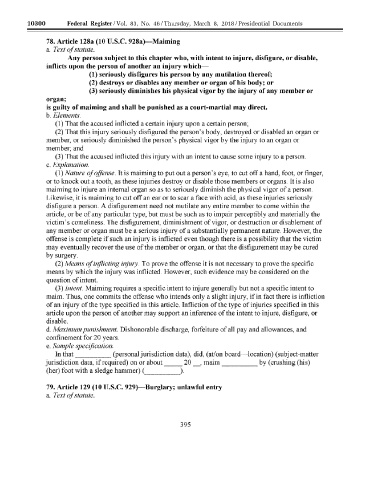Page 597 - Trump Executive Orders 2017-2021
P. 597
10300 Federal Register / Vol. 83, No. 46 / Thursday, March 8, 2018 / Presidential Documents
78. Article 128a (10 U.S.C. 928a)-l\'Iaiming
a. Text of statute.
Any person subject to this chapter who, with intent to injure, disfigure, or disable,
inflicts upon the person of another an injury which-
(1) seriously disfigures his person by any mutilation thereof;
(2) destroys or disables any member or organ of his body; or
(3) seriously diminishes his physical vigor by the injury of any member or
organ;
is guilty of maiming and shall be punished as a court-martial may direct.
b. Elements.
(1) That the accused inflicted a certain injury upon a certain person;
(2) That this injury seriously disfigured the person's body, destroyed or disabled an organ or
member, or seriously diminished the person's physical vigor by the injury to an organ or
member; and
(3) That the accused inflicted this injury with an intent to cause some injury to a person.
c. F:xplanation.
(1) Nature l?foffense. Tt is maiming to put out a person's eye, to cut off a hand, foot, or finger,
or to knock out a tooth, as these injuries destroy or disable those members or organs. It is also
maiming to injure an internal organ so as to seriously diminish the physical vigor of a person.
Likewise, it is maiming to cut off an ear or to scar a face with acid, as these injuries seriously
dis±lgure a person. A dis±lgurement need not mutilate any entire member to come within the
article, or be of any particular type, but must be such as to impair perceptibly and materially the
victim's comeliness. The dis±lgurement, diminishment of vigor, or destruction or disablement of
any member or organ must be a serious injury of a substantially permanent nature. However, the
offense is complete if such an injury is inflicted even though there is a possibility that the victim
may eventually recover the use of the member or organ, or that the disfigurement may be cured
by surgery.
(2) Means of inflicting injwy. To prove the oflense it is not necessary to prove the specific
means by which the injury was inf1icted. However, such evidence may be considered on the
question of intent.
(3) intent. Maiming requires a specific intent to injure generally but not a specific intent to
maim. Thus, one commits the offense who intends only a slight injury, if in fact there is infliction
of an injury of the type speci±led in this article. Infliction of the type of injuries specified in this
article upon the person of another may support an inference of the intent to injure, dis±lgure, or
disable.
d. Maximum punishment. Dishonorable discharge, forfeiture of all pay and allowances, and
confinement for 20 years.
e. Sample specification.
In that (personal jurisdiction data), did, (at/on board-location) (subject-matter
jurisdiction data, if required) on or about __ 20 _,maim by (crushing (his)
(her) foot with a sledge hammer) '-----?
79. Article 129 (1 0 U.S.C. 929)-Burglary; unlawful entry
a. Text Q( statute.
sradovich on DSK3GMQ082PROD with PRES DOCS VerDate Sep<11>2014 18:39 Mar 07, 2018 Jkt 244001 PO 00000 Frm 00414 Fmt 4705 Sfmt 4790 E:\FR\FM\08MRE0.SGM 08MRE0 ER08MR18.416</GPH>
395

